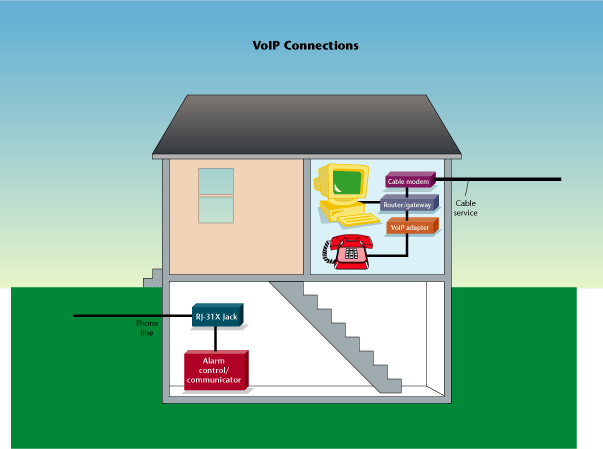VoIP is a “clear and present danger†to traditional alarm communications, and may signal the future demise of the industry’s communication workhorse, the digital communicator. Mark Hillenburg, marketing manager for DMP, Springfield, Mo., says that the potential and growth of VoIP indicates that “the phone line is going away†as the primary platform for alarm monitoring communications.

HOW VoIP WORKS
The technology of VoIP emulates the functions of a standard switched telephone line, but uses the Internet or other IP network to provide the pathway for telephone calls. An IP-addressed interface device is connected to the Internet via a cable modem, DSL adapter, or other ISP link, and provides connections for standard telephone instruments. Once activated and programmed, the VoIP adapter provides a dial tone to the telephone instrument. When a call is placed, the analog sounds from the telephone are sampled and converted into IP data packets, and transmitted over the Internet, where they are converted back into analog at the receiving end.
This technology is also being implemented by local and long distance telephone companies to carry telephone traffic between offices. So it is quite possible that if alarm subscribers’ central stations are located across state lines, at some point in the near future their digital alarm signals may be traveling over VoIP to reach the alarm receiver.
WHY YOUR CUSTOMERS MAY CHANGE TO VoIP
The primary attraction for alarm subscribers to convert from traditional telephone companies to VoIP is lower cost. Customers receive flat-rate billing for local and long distance calls at substantial savings. In most cases subscribers can retain their existing telephone number.Some VoIP providers encourage subscribers to keep their traditional telephone service for emergency use because, unlike traditional telephone connections, VoIP telephones and DSL or cable modems will not operate during power outages unless separate backup power is provided. Also, some telephone companies will not provide DSL service unless customers also purchase traditional voice service.
Another benefit of VoIP is that subscribers can get a phone number outside their own area code. This offers commercial clients the option of having local phone numbers in Dallas, Los Angeles, and New York while the calls are actually being answered in Columbus, Ohio, for example. Many mid- to large-size companies are using VoIP to connect their markets to one call center, as is being done by Per Mar Security of Davenport, Iowa. According to Mike Simpson, vice president and CFO, Per Mar has nearly completed VoIP connections for the major cities it services. When calling a subscriber in Des Moines from the central station in Davenport, using VoIP makes this a local phone call, instead of long distance.
Low cost and unique features are making VoIP services attractive to a growing number of customers. Vonage, a residential and small commercial VoIP provider, says it has more than 175,000 subscriber interfaces currently connected, and is adding more at the rate of 3,000 to 4,000 per week. The penetration of VoIP technology will likely affect urban areas first, and then spread to rural areas as its popularity increases.
Long distance telephone companies are also beginning to use VoIP for interoffice traffic to reduce their bandwidth and servicing issues.
VoIP is going through its initial implementation phase now, with some complaints about service availability, sound quality, and other issues reported by users. Telecom providers are also working together to standardize VoIP protocols and communications to provide seamless communications between their networks.

INSTALLATION PROBLEMS WITH VoIP
Let’s look at the example of a typical residential security system that is monitored via a digital communicator connected to an incoming switched telephone line. This customer uses a cable modem to provide a broadband Internet connection.If this subscriber chooses to connect VoIP, he will install it himself, after receiving a VoIP adapter and software from a provider such as Vonage.
As long as the subscriber retains the existing telephone connection to the alarm panel, security communications would continue uninterrupted. But remember that the primary reason for switching to VoIP is saving money, so it is quite possible that the subscriber will cancel his traditional telephone service, and rely on the cable modem to carry telephone calls and Internet traffic. If this occurs, the alarm system will be unable to communicate.
Unless the subscriber calls the alarm company to ask about connecting his alarm to a VoIP connection and/or the subscriber’s alarm equipment is programmed to transmit a periodic test message, there will likely be no indication that the alarm system’s transmission capability has been disabled until there is an actual alarm, or the client attempts to test his system into the central station.

TRANSMISSION PROBLEMS WITH VoIP
Another concern pertains to whether a particular alarm panel/communicator’s digital format will successfully reach the central station receiver using VoIP.Alarm equipment manufacturers and industry associations have been receiving reports of the incompatibility of certain dialer formats with VoIP. Preliminary testing by the Canadian Alarm & Security Association (CANASA) and some manufacturers indicates that “pulsed†formats such as 3/1, 4/2, SIA, and Radionics modem formats may work, while the DTMF formats such as Contact ID may not.
Testing for format compatibility with VoIP poses many variables, making it difficult to say definitely whether one will or won’t function. Different end users may use VoIP interfaces from different suppliers, just as IP network switches and routing equipment can come from a variety of vendors. Although alarm industry communicators theoretically should work with these devices, problems of network latency can frustrate or defeat the transmission of alarm signals. “Latency†is the concept of the different lengths of time data packets take to travel from one network device to another. When an ISP is in heavy use, data packets will take a longer amount of time to reach their destination, which likely contributes to the instances of problems when transmitting DTMF formats.
These potential variables leave alarm companies with uncomfortable possibilities when connecting digital communicators to VoIP. If subscribers change their VoIP service, ISP, or if the Internet backbone components are changed or rerouted, the communicator may fail to function. It is also important to realize that after the VoIP interface converts the digital communicator’s output into IP data packets, those packets can take various routes through the Internet to reach their final destination. Data packets can and will route through different network segments during a single transmission, so part of the information may reach the central station in usable form, while other parts may not, resulting in a failed communication.

CONNECTION OF DIGITAL COMMUNICATORS TO VoIP
It’s important to note that VoIP providers do not recommend the connection of alarm communicators to VoIP lines. Due to the problems of power backup and communicator formats, alarm communicator manufacturers, in general, also do not encourage such connections.One problem confronting the installer when the subscriber changes to VoIP is establishing a “phone line†connection between the alarm panel/communicator and the VoIP interface. As is seen in the previous illustrations, often the alarm communicator is located in a basement, closet, or storeroom far removed from the VoIP interface, which likely will be in the subscriber’s office. To address this, new cable would need to be installed between the panel and the VoIP interface location, and proper termination to the new VoIP “telephone†line would be needed to provide for line seizure and alarm communications.
With regard to power backup, a CANASA report titled “Voice over Internet Protocol,†by Rick Snook, suggests that some 12 VDC VoIP adapters can be backed up from a power supply with a standby battery. This arrangement could be integrated into the alarm system for power supervision. The DSL adapter or cable modem might need a separate uninterruptable power supply (UPS) to provide backup power. The CANASA report author estimates the total cost for a four-hour UPS capable of powering the DSL adapter and VoIP interface to be $150 to $300 (Canadian).
If a subscriber has converted his or her telephone service to VoIP, or if the telco central office has switched to VoIP for interoffice traffic, thus disabling digital communications, how can alarm signals be restored and maintained? There are a number of alternative communication technologies available to the industry, including wireless transmitters, such as long-range radio and cellular. These alternatives can work well, provided that there is sufficient coverage of the wireless network chosen, and that the alarm company’s central station is equipped to receive such signaling.
ALTERNATIVES TO DIGITAL COMMUNICATIONS
Another method of alarm monitoring turns the subscriber’s Internet connection into the primary path for alarm signaling. DMP (Digital Monitoring Products), Bosch Security Systems, DSC, Honeywell Security (ADEMCO/AlarmNet), and others manufacture a variety of alarm control/communicators and “slave†devices that transmit alarm information directly over the Internet. By connecting the panel or communicator to an Ethernet network that is routed to the Internet, packetized alarm signals can travel to a properly equipped central station anywhere in the world. This Internet alarm monitoring is offered by many major contract central stations, and is therefore available to all alarm companies that wish to use it. IP network alarm communications can be programmed for “polling†from the central station, providing a high level of security and supervision. These transmitters are UL listed for fire alarm and “High Line†AA Security when properly installed, programmed, and monitored. These IP network transmission products use proprietary communication and encryption protocols, so the central station must be equipped to receive the alarm messages. ADEMCO/AlarmNet provides IP monitoring for central stations that have AlarmNet receiving equipment by relaying the IP messages through the AlarmNet radio transmission network, according to Scott Simon, business manager of AlarmNet. This technology allows an AlarmNet-equipped central station to monitor IP alarms without requiring new equipment.
Just as the electronic security industry has witnessed the obsolescence of other communication technologies such as tape dialers, direct wires, and McCulloch loops, many industry experts are convinced that the death of the digital communicator is right around the corner. Lou Fiore, industry consultant and chairman of the Communications Committee for the Central Station Alarm Association, sees a rapid rise in IP network communicators. Fiore says “forget the dialer…why encode analog dialer signals into network data, and decode it at the other end?†Alarm equipment manufacturers are either currently delivering or quickly preparing for the anticipated growth of IP transmitter usage.
HOW DEALERS CAN PROTECT THEIR BUSINESSes
There are three strategies that installing companies should employ to protect their monitored accounts and the revenue associated with them.1. Notify subscribers – Written notices, letters, telephone calls and e-mails can all be used to warn subscribers of the potential danger to the operation of their alarm system if they select VoIP services.
2. Reprogram panels to VoIP-friendly formats and, in anticipation of the growth of VoIP, use VoIP-friendly formats for all new installations.
3. Program all accounts for periodic test messages – If subscribers disconnect their alarm panels by choosing VoIP over a cable modem and then canceling their traditional phone service, periodic test messages are the only way that an installing company can be notified of the communicator’s disconnection before an important alarm activation fails to reach the central station. These test messages are also critical to protecting the integrity of digital alarm monitoring in the event of VoIP technology being introduced into the “back channels†of the telecommunications networks.
Richard Ader, director of sales applications and support for Bosch Security Systems, says that “installing alarm systems without programming test messages is malpractice.†Although this test message option has been available in alarm communicators for many years, a great majority of digitally monitored accounts are not enabled for this vital function. Contract central stations have indicated that the percentage of accounts programmed for this feature, outside of those with open/close reporting, is as low as 3 percent, leaving well over 90 percent of such accounts potentially unmonitored in the event of VoIP implementation, either at the clients’ location or within the telecom network. One reason for this is economic, as contract central stations typically charge an additional fee for test message processing.
There is a way for alarm companies to benefit from customers using VoIP. Clients with VoIP inherently have a broadband Internet connection with either a cable modem, T1 line, or DSL interface, and are prime candidates for the installation of wired or Wi-Fi network cameras. These devices can provide alarm company clients with the ability to view video images (and with certain products receive audio as well) of their home or business from any Internet-connected computer.
The telecommunications networks, which the industry relies on to provide the conduit for alarm monitoring and the revenue it provides, most likely will not modify their VoIP services to accommodate alarm industry digital dialer communications. “VoIP providers could care less about the alarm industry,†Fiore says. Scott Simon of AlarmNet says the reported problems with VoIP are increasing, and there’s “not much you can do except to use alternate technologies†for reliable alarm monitoring.
Alarm equipment manufacturers are delivering alternative devices for alarm transmission, and installing companies will have to shoulder the burden of converting paying subscribers onto IP or other alarm communications technologies, or risk failed communications, potential lawsuits, and reduced revenues from subscriber cancellations.

